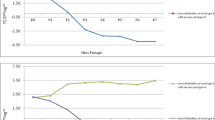Summary
The plaque forming ability of attenuated and field strains of FMDV of types A and O Vallée and C Waldmann were compared in BHK cell cultures. It was found that the vaccine strains attenuated by chick embryo passage produced smaller plaques. Reactor viruses recovered from vaccinated animals generally produced larger plaques than the vaccine and field strains. Type O vaccine, reactor and field viruses produced plaques of less variation in size and morphology. Field viruses of types A and C produced non-clear plaques which are readily distinguishable from the corresponding vaccine and reactor viruses.
All viruses produced larger plaques in the presence of dextran sulfate, whereas the plaque size was reduced with all viruses in the presence of DEAE-dextran. The plaque size and morphology of the field viruses were altered following passage in cell culture. The possible usefulness of these findings in relation to virus markers is discussed.
The results obtained in this study emphasize the necessity of comparing the characteristics of reactor virus with those of the vaccine and field strains.
Similar content being viewed by others
References
Bengtsson, S., Z. Dinter, andL. Philipson: Genetic markers associated with virulence of foot-and-mouth disease virus. Proc. Soc. exp. Biol. (N.Y.)113, 1019–1022 (1963).
Borgen, H. C., andW. Schwöbel: A plaque marker of type C foot-and-mouth disease virus strains from a porcine epizootic. Nature (Lond.)202, 932–933 (1964).
Brooksby, J. B.: Standards for modified strain vaccines on foot-and-mouth disease. Bull. Off. int. Epiz.65, 1941–1947 (1966).
Cottral, G. E., R. E. Patty, P. Gailiunas, andF. W. Scott: Relationship of foot-and-mouth disease virus plaque size on cell cultures to infectivity for cattle by intramuscular inoculation. Arch. ges. Virusforsch.3, 276–293 (1966).
Dinter, Z., L. Philipson, andT. Wesslén: Properties of foot-and-mouth disease virus in tissue culture. I. Changes in plaque morphology and antigenicity following passage in tissue culture. Arch. ges. Virusforsch.9, 411–427 (1959).
MacPherson, I., andM. Stoker: Polyoma transformation of hamster cell clones—an investigation of genetic factors affecting cell competence. Virology16, 147–151 (1962).
Palacios, C. A.: Estudios sobre vacunas de virus vivo contra la fiebre aftosa. Bol. Ofic. Sanit. panamer.68, 386–410 (1968).
Sellers, R. F., L. M. Burt, A. Cumming, andD. L. Stewart: The behavior of strains of the virus of foot-and-mouth disease in pig, calf, ox and lamb kidney tissue cultures. Arch. ges. Virusforsch.9, 637–646 (1959).
Wallis, C., andJ. L. Melnick: Mechanism of enhancement of virus plaques by cationic polymers. J. Virol.2, 267–274 (1968).
Wittmann, G., etR. Ahl: Marqueurs génétiques de souches atténuées du virus aphteux. Bull. Off. int. Epizoot.61, 591–606 (1964).
Author information
Authors and Affiliations
Rights and permissions
About this article
Cite this article
Crandell, R.A., Gomes, I. Plaque morphology of some South American strains of foot-and-mouth disease virus and the effects of polyionic compounds on plaque formation. Archiv f Virusforschung 30, 137–146 (1970). https://doi.org/10.1007/BF01250181
Received:
Issue Date:
DOI: https://doi.org/10.1007/BF01250181




